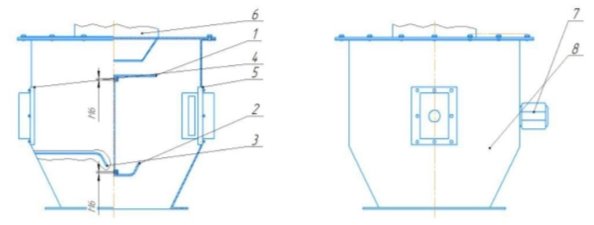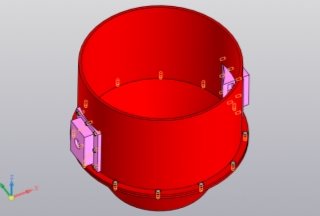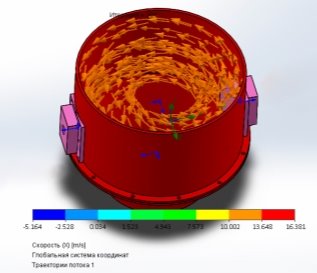The paper deals with the issues related to the seed dressing process, justification of the modernization of the seed dresser and the calculation of the air flow in SolidWorks program.
Keywords: seed dressing, air flow calculation, seed dresser.
Improvement of seed dressing technology is one of the most important directions of modern agricultural practice. Seed dressing helps to increase the yield of cultivated plants, increase their resistance to diseases and pests, as well as improve the quality of the resulting product. However, to achieve maximum efficiency of the dressing process it is necessary to choose the right technology and use effective preparations. In this article we will look at a variant of modernization of the seed treater.
One of the ways to improve the technological process of seed dressing is to add air flow into the dressing chamber. This allows increasing the interaction of the preparation with the seeds and increasing its efficiency.
Various devices such as vacuum pumps, fans, etc. are used for air flow into the etchant chamber. In the process of seed dressing, the chamber is filled with the preparation and then an air flow is created, which mixes the solution and evenly distributes it on the surface of the seeds.
Adding air flow to the treatment chamber also reduces the treatment time, increases the seed's strength and improves its nutritional potential. In addition, this method reduces the likelihood of pathogens on the seed surface, which contributes to higher yields.
Thus, the addition of air flow into the dressing chamber is an effective way to enhance the technological process of seed dressing, which can improve the quality of the resulting product and increase its resistance to external influences.
Components that make up the seed treater (Petkus CT10):

Fig. 1. Petkus CT 10 Treater: 1 — hopper, 2 — sluice dispenser, 3 — cross air separator, 4 — support, 5 — housing additional mixer with mixing paddles, 6 — electric cabinet with touch screen, 7 — discharging throat, 8 — tank for solution, 9 — pipeline, 10 — support, 11 — dressing chamber
Purpose and objective of the study
The aim of the work is to improve the quality and efficiency of the universal stationary seed treater Petkus CT 10 in the cultivation of crops. The task of the work is to improve the design of the seed treater Petkus CT 10 by upgrading the treatment chamber and installing air ducts and fans to create air flows inside the body of the treatment chamber to improve the conditions of coverage of seeds with chemical liquid.
Research Methodology
The advantage of this design is that the air flow generated by the fan affects the seed flow and the flow of the dressing liquid, thus improving the penetration of the liquid into the grain layer. The conditions for seed coverage are improved. In this way, quality seed treatment is ensured.
A study was conducted and it was found that a circulating air flow was created, which follows the shape of the dressing chamber. This makes it possible to reuse the mordant that has not settled on the seeds. It also reduces the mordant flow rate.
The quality of machine operation is evaluated during the whole period of mordant treatment. Uniformity of coverage of seeds with the chemical is controlled visually. If the seeds, chemical agent and suspension are unevenly supplied to the machine, the reasons should be eliminated and their uniform supply to the treatment chamber should be achieved and, if necessary, the mixing time of seeds and chemical agent should be increased. Consumption rate of the pesticide per 1 h should correspond to the calculated one.
The degree of seed injury by the working bodies of the machine is checked visually. If it is impossible, the seeds are sent for laboratory analysis.
Design and operating principle of the modernized treatment chamber
The unmodified Chemical Seed Treater consists of an etch chamber and a top-mounted metering device. The dosing device is designed as a transverse air separator. There are two spraying discs in the treatment chamber and a spigot feeding the slurry located above the distributing disc. Grain enters the mordant chamber, in the center of which a rotating distribution disk is installed, due to centrifugal and gravitational forces the seeds are scattered and form a cylindrical curtain. Below there is a mordant spraying disc. As the disc rotates, the suspension is atomized by centrifugal force onto the seed stream.
This treater has a flaw. Concluding in incomplete treatment of grain, as the suspension is sprayed only on the inner side of the cylindrical seed curtain. And the outer side remains untreated.
To solve the problem, it is proposed to change the design of the wall of the dressing chamber by installing two air ducts opposite each other. Axial fans are installed in the ducts to provide closed air circulation (Figure 2).
The modified etching chamber 8 consists of two spray discs 1 and 2, between which there is a chemical fluid nozzle 3. Also on the walls opposite each other are fixed two ducts 4 and 5, with fans installed in them. Above the treatment chamber there is a sluice dispenser 6 for seed distribution. The operation of this device is as follows. Reducer-motor 7 installed outside the chamber drives two spray discs 1 and 2 to certain revolutions, which can be adjusted. The fans are connected to the electric motor 7.
The operation of this device is as follows. Grain, coming from the dosing chamber 6 falls into the treatment chamber 8 on the rotating atomization disc 1. Further the grain falls down due to centrifugal and gravitational forces falling into the air circulating flow created by two air ducts. The working fluid is fed to the disc 2. After that the sprayed suspension from disk 2 gets into the air stream, where the seeds and the suspension get a circulating direction of rotation. Due to this, the seeds are not only covered with the inner part, but also treated as a whole several times.

Fig. 2. Schematic diagram of the modified etchant chamber: 1 and 2 — spray discs, 3 — slurry pipe, 4 and 5 — air ducts, 6 — sluice dispenser, 7 — motor reducer, 8 — dressing chamber, 9 and 10 — fans
The advantage of this design is that the air flow generated by the fan affects the flow of the seed and the flow of the dressing liquid, thereby improving the penetration of the liquid into the grain layer.
We conducted a study and found that a circulating air flow is created, which follows the shape of the dressing chamber. This makes it possible to reuse the mordant that has not settled on the seeds. And also to reduce the consumption of mordant supply.
Calculating airflow in SolidWorks

Fig. 3. 3D model of the modernized peeling chamber assembly, made in SolidWorks

Fig. 4. Results of airflow trajectory calculation for direction and speed

Fig. 5. Results of airflow trajectory calculation for direction and speed
Conclusion: The air flow has the right direction and the right speed. The airflow-circulates. The velocity of the air flow is kept between 10.002–13.648 m/s. So the velocity will be enough to move the grain.
References:
- Ladanova A. N. Tekhnologiia protravlivaniia semian. Monografiia. M.: Izdatel'stvo ASV, 2016.
- Nazarova I. A., Kiseleva E. V. Metody protravlivaniia semian kul'turnykh rastenii. Integratsiia obrazovaniia. 2019. no 3. S. 220–225.
- Protravlivatel' semian nepreryvnogo deistviia Petkus CT 10. Rukovodstvo po ekspluatatsii i tekhnicheskomu obsluzhivaniiu. [Elektronnyi resurs] http://russian.petkus.de/documents/10194/199080/DB_Beizer %C3#A4t_CT10_RU_Web_20151001.pdf/7f07f44b-9733–43f9–99d9–7db85f3896c2







